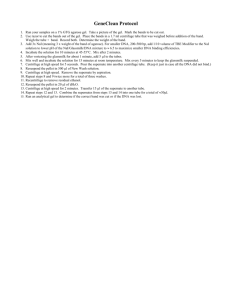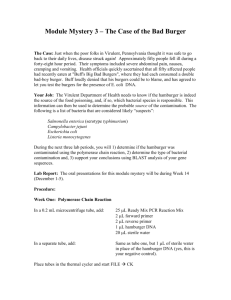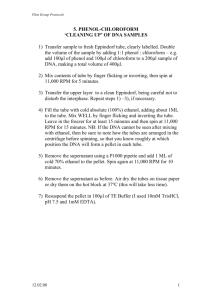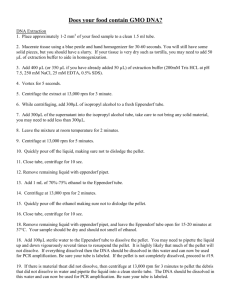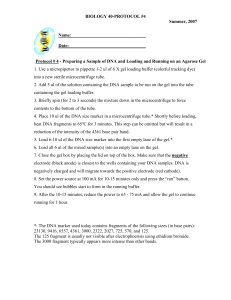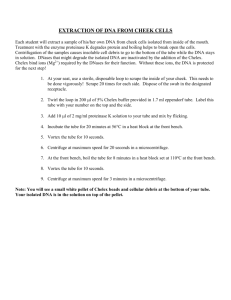4 Heterozygous control (+/-) 10 ul
advertisement
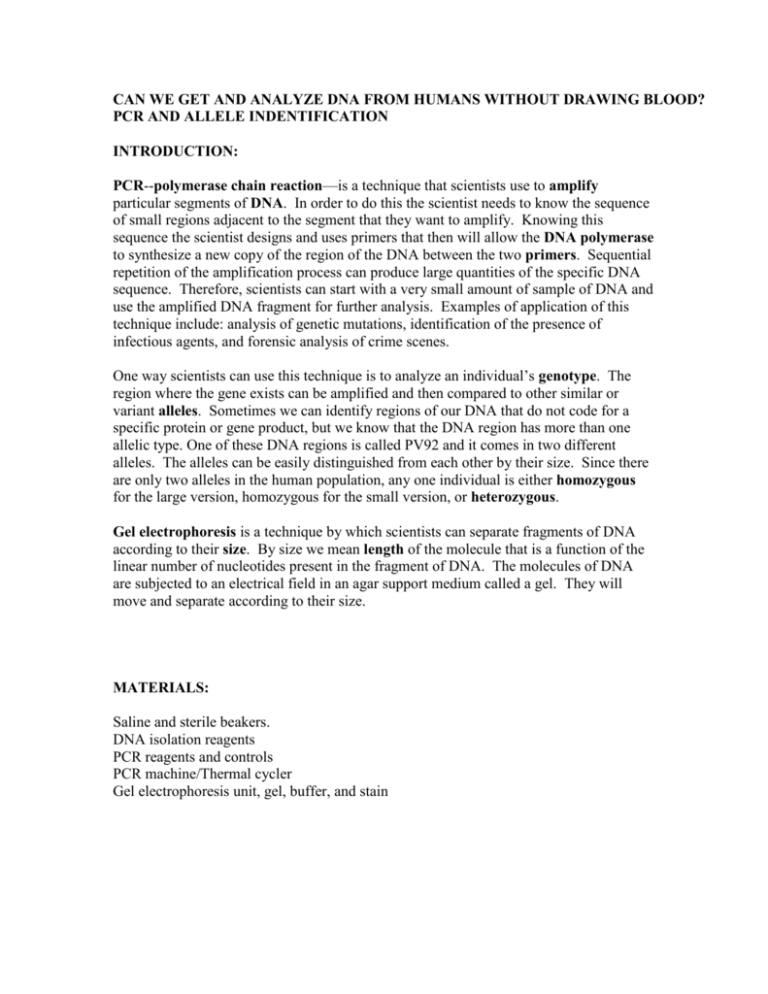
CAN WE GET AND ANALYZE DNA FROM HUMANS WITHOUT DRAWING BLOOD? PCR AND ALLELE INDENTIFICATION INTRODUCTION: PCR--polymerase chain reaction—is a technique that scientists use to amplify particular segments of DNA. In order to do this the scientist needs to know the sequence of small regions adjacent to the segment that they want to amplify. Knowing this sequence the scientist designs and uses primers that then will allow the DNA polymerase to synthesize a new copy of the region of the DNA between the two primers. Sequential repetition of the amplification process can produce large quantities of the specific DNA sequence. Therefore, scientists can start with a very small amount of sample of DNA and use the amplified DNA fragment for further analysis. Examples of application of this technique include: analysis of genetic mutations, identification of the presence of infectious agents, and forensic analysis of crime scenes. One way scientists can use this technique is to analyze an individual’s genotype. The region where the gene exists can be amplified and then compared to other similar or variant alleles. Sometimes we can identify regions of our DNA that do not code for a specific protein or gene product, but we know that the DNA region has more than one allelic type. One of these DNA regions is called PV92 and it comes in two different alleles. The alleles can be easily distinguished from each other by their size. Since there are only two alleles in the human population, any one individual is either homozygous for the large version, homozygous for the small version, or heterozygous. Gel electrophoresis is a technique by which scientists can separate fragments of DNA according to their size. By size we mean length of the molecule that is a function of the linear number of nucleotides present in the fragment of DNA. The molecules of DNA are subjected to an electrical field in an agar support medium called a gel. They will move and separate according to their size. MATERIALS: Saline and sterile beakers. DNA isolation reagents PCR reagents and controls PCR machine/Thermal cycler Gel electrophoresis unit, gel, buffer, and stain METHOD AND PROCEDURES: I. ISOLATION OF DNA. 1. Take two tubes of sterile saline and pour each into a sterile 100 ml beaker. Pour the saline into your mouth and rinse vigorously for 30 seconds. Expel all of the saline back into the beaker. 2. Carefully pour your rinse into a 1.5 ml micro test tube that is labeled with your initials. Alternatively, use a P-1000 micro pipette to deliver 1 ml of your rinse into a micro test tube. Centrifuge the tubes with other student’s samples in the mini centrifuge; be sure the tubes are balanced—there is a similar tube opposite each tube in the centrifuge slots. The centrifugation step should be for 2 minutes at maximum speed. 3. A small whitish pellet should exist at the bottom of the tube. Carefully pour off the solution, referred to as the supernatant back into the beaker. Allow a small amount of liquid to remain and tip the tube upright and flick it down to the bottom. With the top of the tube closed agitate the tube so that the pellet becomes re-suspended in the remaining fluid. 4. Obtain a micro screw-cap tube and place 200 ul of InstaGene solution in it. Then transfer 20 ul of your re-suspended pellet into the InstaGene tube, close the top and mix. Be sure to label with your initials. 5. Using the plastic tube holders and a water bath, incubate your sample at 560 C for 10 minutes. Be sure to briefly mix the incubating tube after 5 minutes and put it right back into the water bath. 6. Remove the tube, mix it again and place it back into the floating tube holder. Place the plastic holders directly into water that is 1000 C and incubate for 10 minutes. 7. Let the tube cool for a few minutes; balance your tube with another student, and when the centrifuge is full centrifuge for 10 minutes at maximum speed. 8. If you are not going to go on to the amplification today, store your tube at 40 C until the next steps. II. PCR AMPLIFICATION OF YOUR DNA 1. Centrifuge your InstaGene sample of DNA for 10 minutes at maximum speed. Careful take the tube out of the centrifuge and note that a pellet of InstaGene matrix beads is at the bottom of the tube. Be careful not to disturb this pellet. 2. Obtain a very small PCR tube and label with your initials. Place the PCR tube into a cap-less micro centrifuge tube and place both into a plastic tube holder. 3. Transfer 20 ul of your DNA sample, now referred to as the DNA template, from your tube into the bottom of the PCR tube. Be sure not to transfer any of the matrix beads that are at the bottom of the InstaGene DNA sample tube. 4. Transfer 20 ul of Master Mix solution, that has been prepared by the Instructor and should be on ice, into your PCR tube. Using the same pipette tip carefully mix the solutions—the DNA template and Master mix by pipetting up and down several times. 5. When all of the students are ready and the instructor has prepared the controls, all of the tubes will be placed into the rack that fits into the thermal cycler. The machine to wil be closed and the appropriate program of cycles will be started. 6. At the end of the amplification the Instructor will place the samples at 40C until the next step. III. GEL ELECTROPHORESIS OF SAMPLES AND CONTROLS. 1. Obtain your sample and with other students do a ‘pulse’ centrifugation to move all of the fluid to the bottom of the tube. Open the tube and add 10 ul of PV92 XC loading dye and gently mix. 2. Obtain one gel unit per four students. Be sure that the wells of the gel are near the negative (-) or black end. Gently pour approximately 275 ml of 1X TAE buffer into the gel unit so that it covers the gel. 3. Using a clean pipette tip for each sample load your gel according to the following scheme: Lane Sample Load Volume 1 MMR DNA standard 10 ul 2 Homozygous control (+/+) 10 ul 3 Homozygous control (-/-) 10 ul 4 Heterozygous control (+/-) 10 ul 5 Student 1 20 ul 6 Student 2 20 ul 7 Student 3 20 ul 8 Student 4 20 ul 4. Carefully secure the lid onto the gel unit matching red-to-red and black-to-black. Plug the leads into the power source also matching colors appropriately. Turn the power supply on and allow to ‘run’ for 30 minutes at constant (100V) voltage. 5. During the electrophoresis, obtain a plastic tray and fill with 120 ml of the staining solution (1X Fast Blast DNA) prepared by the instructor. 6. Colored dyes will be visible indicating movement of molecules in the electrical field. At the end of 30 minutes turn the power source, off, remove the leads and top and carefully, one person with gloves, remove the gel into the waiting staining solution. The gel is very slippery and also can be broken into pieces if handled incorrectly. Gently try to cradle the gel. 7. Allow the gel to stain overnight and then observe. ANALYSIS AND QUESTIONS: 1. What genotype are you? 2. What is the frequency distribution of the class? 3. How does this compare to the expected frequency in the human population?
